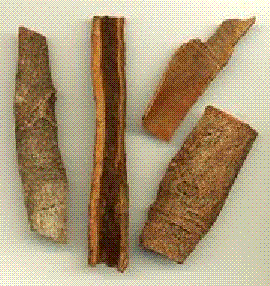

Also known as dalchini in India. It is a curled, rolled, dried bark. Used for flavoring curries and pulaos, it has a sweet flavor and is an ingredient in garam masala.
The name cinnamon is correctly used to refer to Ceylon Cinnamon, also known as "true cinnamon" (from the botanical name C. verum). However, the related species Cassia (Cinnamomum aromaticum) and Cinnamomum burmannii are sometimes sold labeled as cinnamon, sometimes distinguished from true cinnamon as "Indonesian cinnamon" or, at least for Cassia, "Bastard cinnamon". Ceylon cinnamon, using only the thin inner bark, has a finer, less dense and more crumbly texture, and is considered to be less strong than cassia. Cassia is generally a medium to light reddish brown, is hard and woody in texture, and is thicker (2-3 mm thick), as all of the layers of bark are used. Most of the cinnamon sold in supermarkets in the United States is actually cassia. European health agencies have recently warned against consuming high amounts of cassia, due to a toxic component called coumarin.[1]This is contained in much lower dosages in Ceylon cinnamon and in Cinnamomum burmannii. Coumarin is known to cause liver and kidney damage in high concentrations
Cassia (Cinnamomum aromaticum, synonym C. cassia), also called Chinese cinnamon, is an evergreen tree native to southern China and mainland Southeast Asia west to Myanmar. Like its close relative, Cinnamon (Cinnamomum zeylanicum, also known as "true cinnamon" or "Ceylon cinnamon"), it is used primarily for its aromatic bark, which is used as a spice.
The Cassia tree grows to 10-15 m tall, with greyish bark, and hard elongated leaves 10-15 cm long, that have a decidedly reddish colour when young.
| < Prev | Next > |
|---|
















